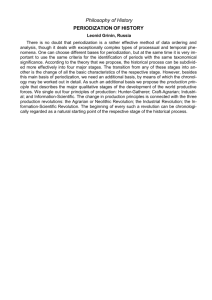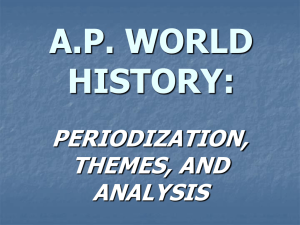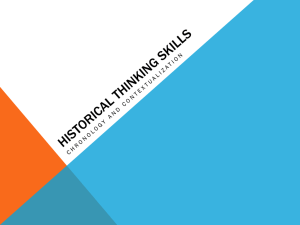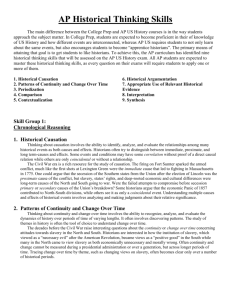Periodization - Enrichment - White Plains Public Schools
advertisement
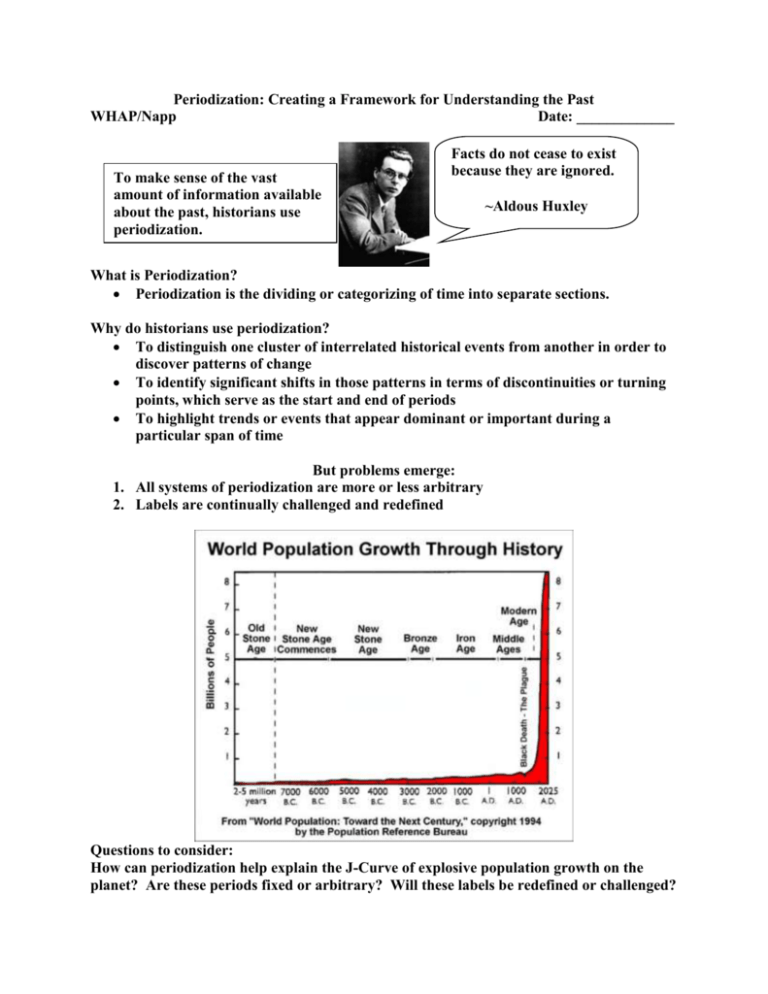
Periodization: Creating a Framework for Understanding the Past WHAP/Napp Date: _____________ To make sense of the vast amount of information available about the past, historians use periodization. Facts do not cease to exist because they are ignored. ~Aldous Huxley What is Periodization? Periodization is the dividing or categorizing of time into separate sections. Why do historians use periodization? To distinguish one cluster of interrelated historical events from another in order to discover patterns of change To identify significant shifts in those patterns in terms of discontinuities or turning points, which serve as the start and end of periods To highlight trends or events that appear dominant or important during a particular span of time But problems emerge: 1. All systems of periodization are more or less arbitrary 2. Labels are continually challenged and redefined Questions to consider: How can periodization help explain the J-Curve of explosive population growth on the planet? Are these periods fixed or arbitrary? Will these labels be redefined or challenged? More Thoughts on Periodization Definition of Periodization: A conceptual tool that makes change over time manageable by identifying big changes Implied Watersheds: Developments or events that occurred in world history affecting the most people Criteria for periodization: Change (political, economic, cultural, biological) in relation to the “masses” Three Overlapping Shifts: Three overlapping shifts across societies must occur for a new period of world history to be identified 1. The world map must change significantly (Cultural, political, or economic boundaries; migrations) 2. New kinds of contacts must be established among civilizational areas (New trade patterns, outreach of religions) 3. New parallelisms must arise in patterns displayed by major civilizations (Example: “The fall of the great empires meets the requirements. Cultural and political boundaries shifted in India and the Mediterranean world. Buddhism, Christianity, and Islam spread widely. The Islamic world replaced India as the most expansive civilization.”) Periodization in World History I. 8000 BCE-600 CE (Foundations) Neolithic Revolution, Urban Revolution, Rise of Civilizations, River Valley Civilizations and expansionist civilizations (classical world) II. 600 BCE-1450BCE (Post-classical) Significant for the spread of the “world religions” even though some like Christianity and Buddhism began to spread before this period while Islam spread during this period, the political systems which followed the classical empires - the Han, Roman, and Gupta Empires - fell at different times but by the 7th century, post-classical political systems were emerging III. 1450-1750 (The Early Modern Period) The Portuguese began exploring the coast of Africa in the 15th century and by the end of century, Europeans had reached both the Americas and the East Indies. The intellectual (Renaissance, Scientific Revolution), social (Protestant Reformation), economic (Commercial Revolution), and political (absolutism) changes in European impacted other regions. However, changes were occurring elsewhere in the world that also had global significance (Ottomans, Safavids, Mughals, Mings, the cessation of Zheng He’s explorations, primacy of Moscow over Kiev, and the end stage of feudalism in Japan). IV. 1750-1914 (The Modern Era) The Enlightenment, revolutions in the Americas, the beginning of the Industrial Revolution, and a second round of European imperialism led to a shift in Europe and the West’s relationship to other regions V. 1914-Present (Contemporary) The beginning of many “modern” changes in technology and accelerated global interactions, the World Wars, the collapse of European imperialism, the Cold War and its impact on former colonial regions, American hegemony List ten of the most significant events in all of world history affecting the greatest number of people: _________________________ ________________________ _______________________ _________________________ ________________________ _______________________ _________________________ Excerpt from Jerry H. Bentley, “Cross-Cultural Interaction and Periodization in World History” The American Historical Review, Volume 101, no. 3 (June1996): 749-770. “Periodization ranks among the more elusive tasks of historical Scholarship. As practicing historians well know, the identification of coherent periods of history involves much more than the simple discovery of self-evident turning points in the past: it depends on prior decisions about the issues and processes that are most important for the shaping of human societies, and it requires the establishment of criteria or principles that enable historians to sort through masses of information and recognize patterns of continuity and change. Even within the framework of a single society, changes in perspective can call the coherence of conventionally recognized periods into question, as witness Joan Kelly’s famous essay “Did Women Have a Renaissance?” or Dietrich Gerhard’s concept of “old Europe.” When historians address the past from global points of view and examine processes that cross the boundary lines of societies and cultural regions, the problems of periodization become even more acute. Historians have long realized that periodization schemes based on the experiences of Western or any other particular civilization do a poor job of explaining the trajectories of other societies. To cite a single notorious example, the categories of ancient, medieval, and modern history, derived from European experience, apply awkwardly at best to the histories of China, India, Africa, the Islamic world, or the Western hemisphere—quite apart from the increasingly recognized fact that they do not even apply very well to European history. As historians take global approaches to the past and analyze human experiences from broad and comparative perspectives, however, questions of periodization present themselves with increasing insistence. To what extent is it possible to identify periods that are both meaningful and coherent across the boundary lines of societies and cultural regions? What criteria or principles might help historians to sort out patterns of continuity and change and to distinguish such periods?” A- What problems do historians face as they construct historical periods? B- Why does periodization based on a particular civilization pose problems to historians? C- Why is periodization particularly challenging for world historians? D- How do the goals of world historians inform the debate on periodization? 1- Explain the quote: “Strictly speaking, there are no periods in history, only in historians’ analyses.” 2- Why is the debate on historical dating (BC versus BCE…AD versus CE) a source of concern for world historians? 3- What criteria can historians use to make distinctions among sections of time? 4- List the top ten technological developments prior to the Industrial Revolution. 5- Historians distinguish between primary and secondary sources. However, primary and secondary sources, while providing information about the past, pose problems as well to historians. What problems do primary and secondary sources pose? 6- World Historians often refer to three distinct phases in world history (the Paleolithic Period, the Neolithic Revolution, and the Industrial Revolution). Of course, using the course’s periodization, a more specific framework has been created. Why is the course’s periodization more elaborate than the “three phases” approach? 7- Consider the question posed by Joan Kelly: “Did women have a Renaissance?” Why is this question significant for world historians and how does this question present a challenge to the notion of periodization? 8- World historians are very interested in social class structures. How can social class structures alter the telling of history? 9- Consider this: The three Cs of World History: Change, Connections, and Comparison allow for a framework for analysis for exploring the themes of World History. The themes of World History are Interaction between humans and the environment (Demography and disease, migration, patterns of settlement, and technology) Development and interactions of culture (Religions, Belief Systems, Science and technology, Arts and Architecture) State-building, expansion, and conflict (Political systems; Empires; Nations and nationalism; Revolts and revolutions; Regional and Global structures) Creation, Expansion, and Interaction of Economic Systems (Agriculture, Pastoralism, Trade, Commerce, Labor Systems, and Capitalism and Socialism) Development and transformation of social structures (Gender roles, Family, Racial and Ethnic Constructions, and Social and Economic Classes)
